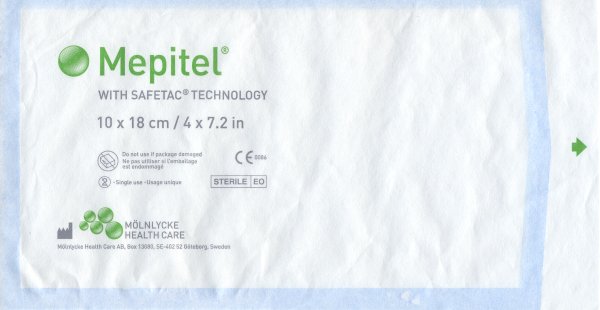
| Product Name: | Mepitel |
| Classification Name: | Soft silicone primary wound dressing |
| Manufacturer: | Mölnlycke Health Care |

Mepitel is a porous, semi-transparent, low-adherent wound contact layer, consisting of a flexible polyamide net coated with soft silicone. The silicone coating is slightly tacky, which facilitates the application and retention of the dressing to the peri-wound area. This gentle adhesion also tends to prevent maceration by inhibiting the lateral movement of exudate from the wound on to the surrounding skin.
The nature of the bond that forms between Mepitel and the skin surface is such that the dressing can be removed with minimum pain and without damaging delicate new tissue.
Mepitel is not absorbent, but contains apertures or pores approximately 1mm in diameter that allow the passage of exudate into a secondary absorbent dressing.
Mepitel is used in the management of wounds where adherence of a dressing to the underlying tissue represents a particular clinical problem. Typical applications include skin tears or abrasions, surgical excisions, second-degree burns, blistering conditions such as epidermolysis bullosa, lacerations, partial and full thickness grafts, and skin damage following radiotherapy or steroid therapy.
The manufacturers have identified no absolute contra-indications to the use of Mepitel.
The dressing is supplied between two layers of plastic film, which must be removed before use. Prior to application, if clinically indicated, the wound should be cleansed and the surrounding skin thoroughly dried. A dressing should be selected that overlaps the wound margin by at least two centimetres and, if necessary, this may be cut to size or shape before removal of the protective films. If more than one piece of Mepitel is required, the dressings may be partially overlapped, ensuring that the pores are not blocked. Moistening gloves with sterile water or saline will help to stop the dressing sticking to the fingers and thus facilitate application. Once in position the dressing should be smoothed into place, ensuring a good seal with the surrounding skin, and covered with an appropriate absorbent secondary dressing and a suitable fixation device or bandage.
In contoured or jointed areas (e.g. under arm, under breast, inner elbow, groin, deep wounds), it is important to ensure that sufficient padding is applied to keep the Mepitel in intimate contact with the wound surface.
Where clinically indicated, topical steroids or antimicrobial agents can be applied either over or under Mepitel.
Depending on the nature and condition of the wound, Mepitel may be left in place for extended periods, up to 7-10 days in some instances, but the outer absorbent layer should be changed as frequently as required. When Mepitel is used for the fixation of skin grafts and protection of blisters, it is recommended that the dressing should not be changed before the fifth day post-application.
As with all types of dressings, wounds should be regularly monitored for signs of infection or deterioration. When used on bleeding wounds, or wounds producing high viscosity exudate, Mepitel should be covered with a moist absorbent dressing pad. If Mepitel is used on burns treated with meshed grafts, or applied after facial resurfacing, imprints can occur if excess pressure is placed upon the dressing. Following facial resurfacing it is recommended that the dressing be lifted and repositioned at least every second day.
Mepitel is supplied individually wrapped in paper peel pouches, sterilised by ethylene oxide.
1. Vloemans, A. F., Kreis, R. W. Fixation of skin grafts with a new silicone rubber dressing (Mepitel). Scand J Plast Reconstr Surg Hand Surg 1994; 28(1): 75-76.
2. Adamietz, I. A., Mose, S., Haberl, A., Saran, F. H., Thilmann, C., Bottcher, H. D. Effect of self-adhesive, silicone-coated polyamide net dressing on irradiated human skin. Radiation Oncology Investigations 1995; 2: 277-282.
3. Dahlstrom, K. K. A new silicone rubber dressing used as a temporary dressing before delayed split skin grafting. A prospective randomised study. Scand J Plast Reconstr Surg Hand Surg 1995; 29(4): 325-327.
4. Gotschall, C. S., Morrison, M. I., Eichelberger, M. R. Prospective, randomized study of the efficacy of Mepitel on children with partial-thickness scalds. J Burn Care Rehabil 1998; 19(4): 279-283.
5. Bugmann, P., Taylor, S., Gyger, D., Lironi, A., Genin, B., Vunda, A., et al. A silicone-coated nylon dressing reduces healing time in burned paediatric patients in comparison with standard sulfadiazine treatment: a prospective randomized trial. Burns 1998; 24(7): 609-612.
6. O'Donovan, D. A., Mehdi, S. Y., Eadie, P. A. The role of Mepitel silicone net dressings in the management of fingertip injuries in children. J Hand Surg [Br] 1999; 24(6): 727-730.
7. Schober-Flores, C. Epidermolysis bullosa: a nursing perspective. Dermatol Nurs 1999; 11(4): 243-248, 253-246.
Further information on obtaining Mölnlycke products is available on
the Mölnlycke web
site.
| Revision Author | Dr S. Thomas |
| Revision No | 2.6 |
| Revision date | 2009/05/21 |
This datacard has been prepared from data provided by the manufacturer and/or from published literature.